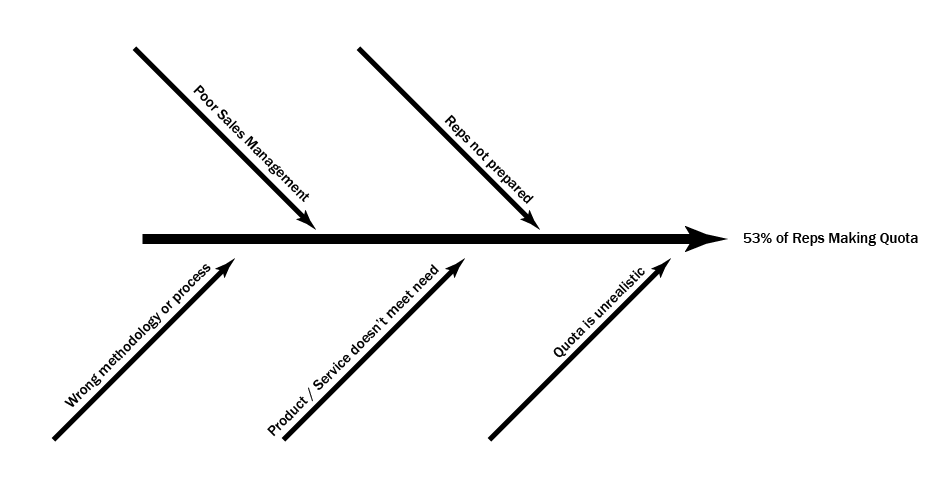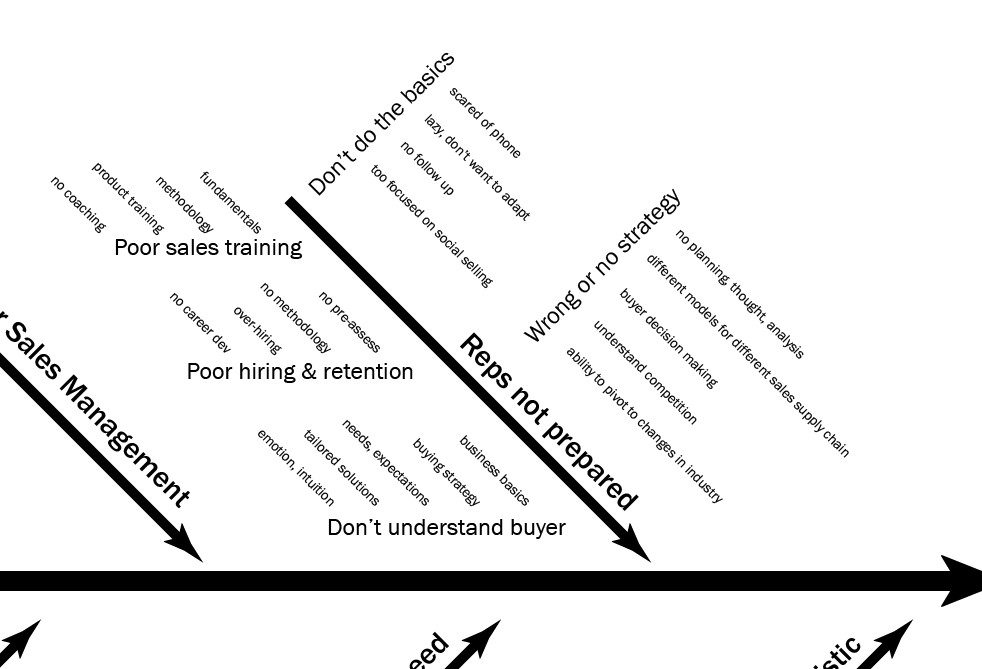Posts in Category: Sales Enablement


Does Sales Enablement require experience in sales?
In the spirit of transparency and candor, let me say that I have a definite opinion about this question and its answer. My view is based on my personal journey coming to Sales Enablement by way of training, learning and performance, data analytics and content management, rather than from a sales background.
That said, I’m not convinced that Sales Enablement can function fully without some sales “street cred.” In my previous role I collaborated very closely with a highly experienced and respected sales leader as a peer within an SE function. This sales expert was the “front of the house” – conducting onboarding quick starts, readiness bootcamps, peer- and manager-based assessment, and sales best practice calls.
However, that, of course, is not the whole story. If it were just about selling skills, Sales would already have all the knowledge necessary. Each sales organization is the world leader in expertise selling its solutions to its customers! The model of “sales-expert-instructor-led-training” is giving way to peer-to-peer coaching and review, knowledge sharing and team-based selling. This is an approach to the sales skills training aspect that I recommend when the SE function consists of a single SE practitioner.
And then we come to data, analytics, supporting infrastructure and technology, curriculum and certification program management and content governance– topics which probably make the eyes of most sales people roll into the back of their heads as they either keel over or run screaming from the room. These skills are found in practitioners at the opposite end of the behavioral spectrum- structured, detailed, analytical, programmatic, data-driven- from that of the archetypal account rep.
One issue here is the variance in definitions for Sales Enablement. I was gratified to find HubSpot defining Sales Enablement as data, technology and content– just where I fit in. But of course, that’s what HubSpot would want it to be.
The Sales Enablement Society has a more impartial and detailed working definition, which is result of a lot of collaborative work over the last year:
Sales Enablement ensures buyers are engaged at the right time and place by client-facing professionals who have the optimal competencies, together with the appropriate insights, messages, content and assets, to provide value and velocity throughout the buying journey. Using the right revenue and performance management technologies and practices, along with leveraging relevant cross-functional capabilities, Sales Enablement optimizes the selling motion and supporting processes in order to increase pipeline, move opportunities forward and win deals more effectively to drive profitable growth.
Note that this says very little about experience selling- it is mainly about the tools, processes and resources to support a complex sale mapped to the buyer’s journey.
So with all that, the question remains, and perhaps the answer is we need a hybrid approach that combines both in-field sales experience and credibility with the analytics, governance and management. This combination in one individual seems to me to be true “purple squirrel” territory, and effective sales enablement teams should perhaps be no smaller than two, and include at least one representative from both arenas.


Root Cause Analysis- Part 2
In the previous post, I compiled a long list of possible reasons why, in general, Sales Reps are not making their numbers.
Since we don’t have infinite time or resources, where should we focus our efforts to “move the needle” for sales? We can guess, from Pareto’s “80/20” rule, that there is a smaller number of items that have outsized impact on our results.
Fortunately, we have a number of tools to help us focus our improvement efforts. I’ll start with a few that I learned at my very first corporate job, as a file clerk at Chevron Pipeline Company, which, at the time, was pursuing a W. Edwards Deming-style quality improvement program.
In order to determine causation a number of factors need to be measured and analyzed. We’ve done the brainstorming of possible causes, and we can use a Cause-and-Effect or “Fishbone” diagram to try and understand the structure of causes.
Warning: In-the-weeds geek analysis ahead.
Start with a single horizontal line and arrow pointing to the effect.

Next we group the short list of possible causes into primary or direct causes, so.

The first thing to notice is that there are multiple primary or direct causes, all of which probably contribute (but not equally) to the effect. Second, we should be clear that this list may not be complete. Finally, some of the suggested causes may not be correct, or may be at the wrong level.
It’s important not to get caught too up in these details at this point- what we are doing is building a shared, testable model or hypothesis about what’s going on. Just know that there’s complexity here and we are probably missing some detail. “All models are false. Some are useful.”
Next, let’s take one of these branches and break it down further. The “Reps not prepared” branch is usually where we look first, so I’ll take that one.

Now we’ve organized our branch into a set of 1 primary, 5 secondary (e.g. Poor sales training) and 22 tertiary (e.g. fundamentals) contributing factors.
Why go to all this effort?
Most importantly, I would say, is that this helps avoid the “jump-to-solution” issue. “More sales training!” “Different strategy!” “Fire the losers!”
Second, nearly as importantly, we capture our thinking about the problem space in a structured communication artifact.
Finally, we can design metrics and testing to validate hypotheses before taking action, spending time and money allocating resources to projects that may or may not pay off.
Root Causes of Sales Reps not meeting quota
I had an “aha!” moment a week or so ago reading through a thread on LinkedIn with a prompt: “Salespeople are getting worse.”
Why are only 53% of Account Execs (Reps) making quota? This stat comes from a CSO Insights report from Miller Heiman.
Reading through the extensive list of comments on the thread one finds many, many, MANY thoughts on what the problem might be.
- Lack of understanding about the Customer’s:
- business fundamentals
- buying strategy
- needs and desired outcomes
- service and support expectations
- need for tailored solutions
- emotional or intuitive buying responses
- Company
- unrealistic quotas, not based on benchmarks or historical data
- Rising quotas
- unhealthy growth expectations
- goals not based in reality
- goals inconsistent or not communicated
- Weak vision
- Scattered products
- No GTM strategy
- Poor culture
- Hiring / Retention
- no methodology
- no pre-assessment or vetting of candidates
- Over-hiring
- More reps fighting for same attention
- Career development
- Sales Training
- how to sell at the company- sales process
- Reps don’t want to adapt or learn
- Should cover planning, thoughtfulness, positioning, analysis of decision-making, competition
- Should include coaching and continuous learning
- Fundamentals for reps and leaders
- Ability to pivot on changes in industry
- Different models for sales supply chains
- Sales AND management training for managers
- Manager coaching training, both sales and management
- Product Training
- time, support and tools to understand product
- Effectiveness of product training
- Market and Environment
- Product offering meets actual need in the market
- Changes to demographics, technology, buyer behavior and expectations
- Digital disruption
- Empowered and informed buyers
- Sales Management
- VPs coaching DOSs coaching AEs
- Not open-minded to feedback or willing to change strategy
- Don’t know how to sell
- Obsessed with meaningless metrics
- “Blowtorch” management
- Sales Reps
- don’t want to work, marketing has made them lazy
- Scared of the phone
- Ability to challenge the buyer’s thinking
- Don’t do proper follow up
- Too focused on social selling
- Process
- Lots of gurus selling theory
- Picking the RIGHT process
- Funnel / pipeline problems
- Cycles have changed
- Need a holistic analysis of the process
- Need to automate the 64% of non-selling time
- Product
- doesn’t work, not viable
- pricing is wrong
- Sales Ops
- use data and data science to reassess strategy and improve
- Sales Ops identify trends not seen by Reps
- Stop seeing Sales Ops as overhead
- Doesn’t even exist in many orgs
That’s from ONE POST!
My question and “aha!” moment: who is analyzing all this to get to the 20% of these causing 80% of the gap? Which are Root Causes and which are Symptoms? Is anybody even doing correlation analysis (the first step) to see which of these might be root causes? I suspect there is a lot of guessing and tossing darts going on.
In a future post I’ll talk about some of the geeky details of how we answer these questions.

Recent Comments